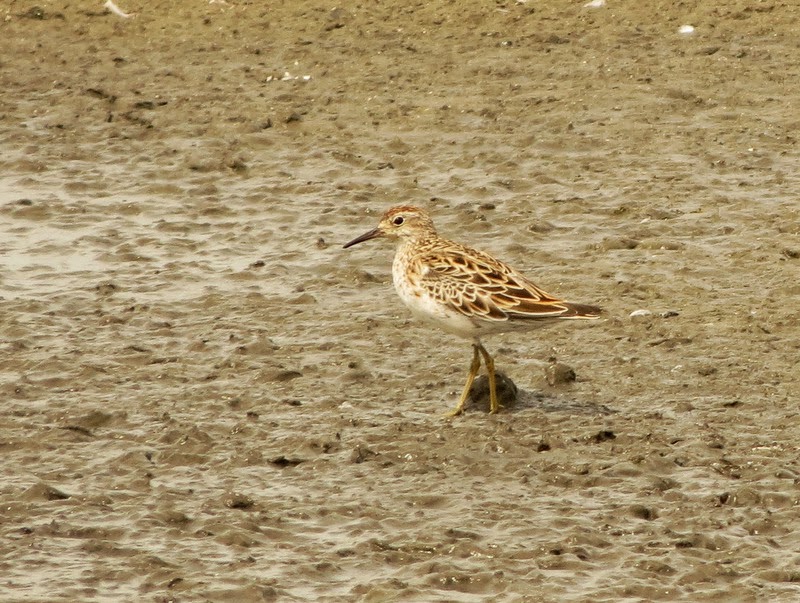The Werribee Treatment Plant is a place that I had been wanting to get to for ages but I had just never gotten around to organising a key for access. Thankfully Sarah managed to sort out a key last week for us and on Wednesday we finally took a drive out to Werribee.
I had heard that the WTP is one of the best birding places in Victoria but I was not prepared for what I saw. WOW! The place is AMAZING. Everywhere you looked there were birds.
We headed in along Paradise Rd. A tractor was working in the neighboring paddock and a group of 6 Black Kites circled above the freshly ploughed dirt. We pulled the car over and got out in the hopes that they might come a little closer. Boy did they come closer! They started circling just above our heads and landing in the paddock beside us. It was an awesome sight and a new tick to my list.
 |
| Black Kite, Milvus migrans |


Their camouflage in the dusty paddock was amazing and at times we lost site of them until they moved.
On the opposite side of the road, a family of Zebra Finches hung out in the trees.
 |
| Zebra Finch, Taeniopygia guttata |
Entering Gate 6, our jaws dropped. With lakes on either side of the road lined with reeds and small shrubs you couldn't look in any direction without seeing a bird. Hundreds of waterbirds filled the lakes, small birds flitted amongst the reeds and shrubs, more birds flew overhead. We were so overwhelmed we didn't know which way to point our cameras first!
 |
| Australian Pelican, Pelecanus conspicillatus |
One of my hopes for the day was to see and photograph a Golden-headed Cisticola. I saw one as soon as we drove through the gate and was bitterly disappointed to get 3 blurry shots before it flew off. I spent a good 10 minutes wandering around trying to find it again before giving up and getting back in the car.
A few metres up the road we stopped for good views of Australian Shelducks and Yellow-billed Spoonbills. I was waiting for Sarah to finish taking photos when I happened to glance out my window and see a tiny little golden bird perched on a branch right beside me. I held my breath as I got my camera up and into focus. The gorgeous Golden-headed Cisticola was happy preening itself on its perch and gave us plenty of time to get lots of great shots. It was very hard to narrow it down to just these 4!
 |
| Golden-headed Cisticola, Cisticola exilis |
 |
| Yellow-billed Spoonbill, Platalea flavipes |
 |
| White-fronted Chat, Epthianura albifrons |
 |
| European Goldfinch, Carduelis carduelis |
It was only 2 weeks ago that I excitedly saw my first Pink-eared Duck. Well now I've seen more than I could ever have imagined. Everywhere we looked we saw more of these beautiful ducks.
 |
| Pink-eared Duck, Malacorhynchus membranaceus |
Looking back we had great views of the You Yangs and saw a whirly whirly from back where the tractor was working the paddock.
The next section we drove was clearly where all the birds of prey hung out - a Peregrine Falcon, Whistling Kites and a Black-shouldered Kite - all perching nicely for us.
 |
| Peregrine Falcon, Falco peregrinus |
 |
| Whistling Kite, Haliastur sphenurus |
 |
| Black-shouldered Kite, Elanus axillaris |
As we got closer to Port Phillip Bay we started to see more shorebirds. Many were starting to show their brilliant breeding plumage.
 |
| Sharp-tailed Sandpiper, Calidris acuminata |
 |
| Red-necked Stints & Curlew Sandpipers |
 |
| Red-necked Stint, Calidris ruficollis |
Two different species of Tern added one more tick to my list.
 |
| Whiskered Tern, Chlidonias hybrida |
 |
| White-winged Black Tern, Chlidonias leucopterus |
 |
| Welcome Swallow, Hirundo neoxena |
 |
| Golden-headed Cisticola, Cisticola exilis |
 |
| Fairy Martin, Petrochelidon ariel |
 |
| Australasian Pipit, Anthus novaeseelandiae |
 |
| Superb Fairy Wren, Malurus cyaneus |
 |
| Brown Goshawk, Accipiter fasciatus |

And to finish up the day we were happily entertained by this Striated Fieldwren as it sung loud and proud on the top of a bush. Another new spotting for me and a great finish to the day.
 |
| Striated Fieldwren, Calamanthus fuliginosus |
After 3hrs we were exhausted. I felt like I had eye strain from seeing so much and we had only covered one third of the plant. I came away with 4 new spots to bring my tally up to a grand total of 218. Can't wait to go back!













































































